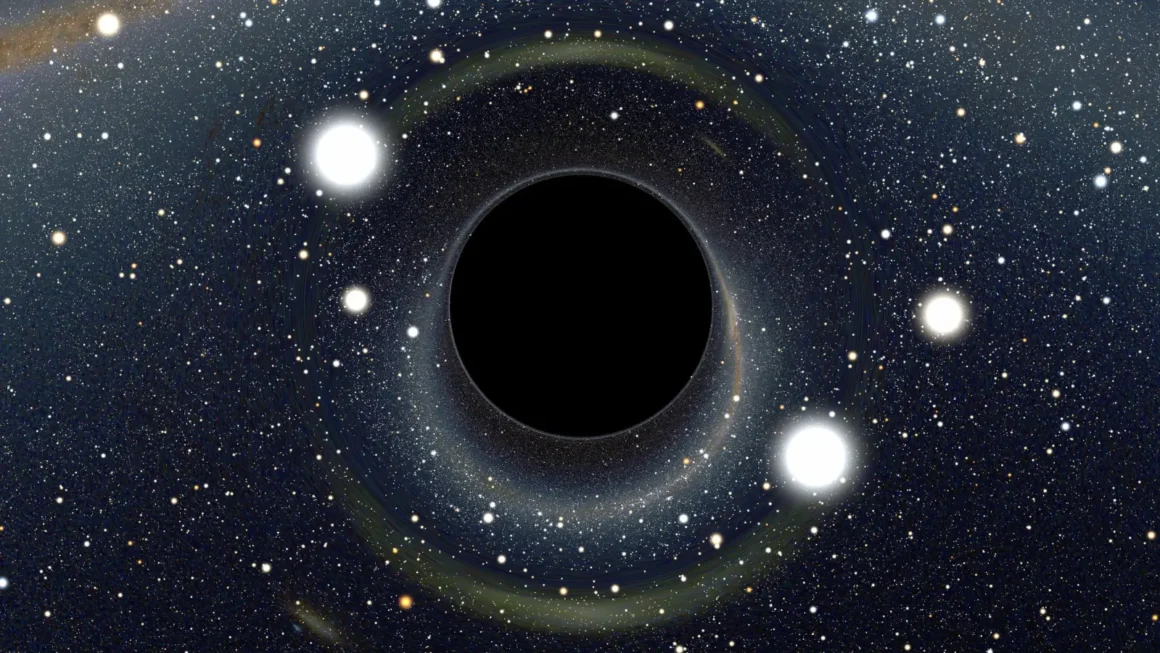For the first time, a rogue black hole has been discovered on its own.
According to astronomers, the solitary stellar-mass black hole is the first of its sort to be discovered.
This NASA picture represents a lone black hole in space, with its gravity distorting the view of stars and galaxies in the backdrop.
According to recent research, astronomers may have identified and measured the mass of an isolated stellar-mass black hole for the first time.
Previous studies revealed that when giant stars with more than 20 times the mass die, they generally perish in cataclysmic explosions known as supernovas.
Their dense cores are likely to collapse to produce black holes.
The study’s primary author, Kailash Sahu, an astronomer at the Space Telescope Science Institute in Baltimore, said that roughly 100 million stellar-mass black holes in the Milky Way should be.
In contrast to supermassive black holes, which may be millions or billions of solar masses in size, stellar-sized black holes can be a few times the sun’s mass.
Black Holes Never Wandering Alone In the Dark Cold Cosmos
Until far, all stellar-mass black holes discovered have been in binary systems with companions like neutron stars.
According to Sahu, the bulk of the Milky Way’s stellar-mass black holes should be singletons.
However, according to Sahu, nobody has ever found an isolated black hole.
As their name implies, black holes absorb all light that enters them, making them impossible to detect in the darkness of space.
In binary systems, black holes are simpler to detect because their interactions with their companions may emit light or gravitational waves, the features of which indicate the existence of a black hole.
On the other hand, Isolated black holes lack such companions to expose their existence.
Scientists have identified an isolated stellar-mass black hole around 5,150 light-years distant from Earth, in the direction of the bulge in the heart of the Milky Way, using NASA’s Hubble Space Telescope.
Sahu said:
“We now know that isolated black holes exist. And they have masses similar to the black holes found in binaries. And there must be lots of them out there.”
The key to understanding this finding is how enormous gravitational forces, such as those produced by black holes, bend the material of space and time.
As a result, they may behave as magnifying glasses, known as “gravitational lensing.”
“If one can detect and measure the bending of light caused by these massive objects, it’s possible to detect them and measure their masses,” Sahu added.
Every night, various ground-based survey programs scan millions of stars to identify gravitational lensing events, when a star gradually brightens and fades over days or months, according to Sahu.
This microlensing effect is created by an intervening object, a star, a white dwarf, a neutron star, a black hole, or anything else.
Each year, the survey algorithms identify around 2,000 microlensing incidents.
A limited fraction of them is thought to result from black holes.
The longer the ensuing brightness, the bigger the mass of a gravitational lensing object.
Because a black hole is supposed to be huge, its microlensing event should last long.
Sahu added:
“Also, a black hole is expected to be dark. So we use these two as our main criteria — the event should have a long duration, and the lens should not be emitting any light.”
Small-mass stars that move slowly in the sky, on the other hand, may seem relatively dark and cause long-duration gravitational lensing events.
According to Sahu, one technique to tell an isolated black hole from a small-mass star is that a black hole will deflect light from background stars “enough that it can be detected with Hubble,” according to Sahu.
If the Hubble measurements indicate significant deflection but no light from the lens, it is a black hole.
The scientists identified a 270-day-long microlensing event named MOA-2011-BLG-191/OGLE-2011-BLG-0462 by merging Hubble views with ground telescope data, which they believe was caused by an isolated black hole.
Sahu added it took two years of preparation and six years of Hubble observations, but it was gratifying to see the spectacular findings. It was evident as day that it was a black hole; nothing else could have caused the deflections scientists observed.
The astronomers calculated that this solitary black hole weighed about 7.1 times the sun’s mass.
They also discovered that this black hole is moving at a speed of roughly 100,000 miles per hour (162,000 kph).
This indicates that the supernova explosion that created it may have boosted this black hole.
Future observatories like the Nancy Grace Roman Space Telescope and the Vera C. Rubin Observatory in Chile, according to Sahu, may enormously help in the discovery of additional isolated stellar-mass black holes.
